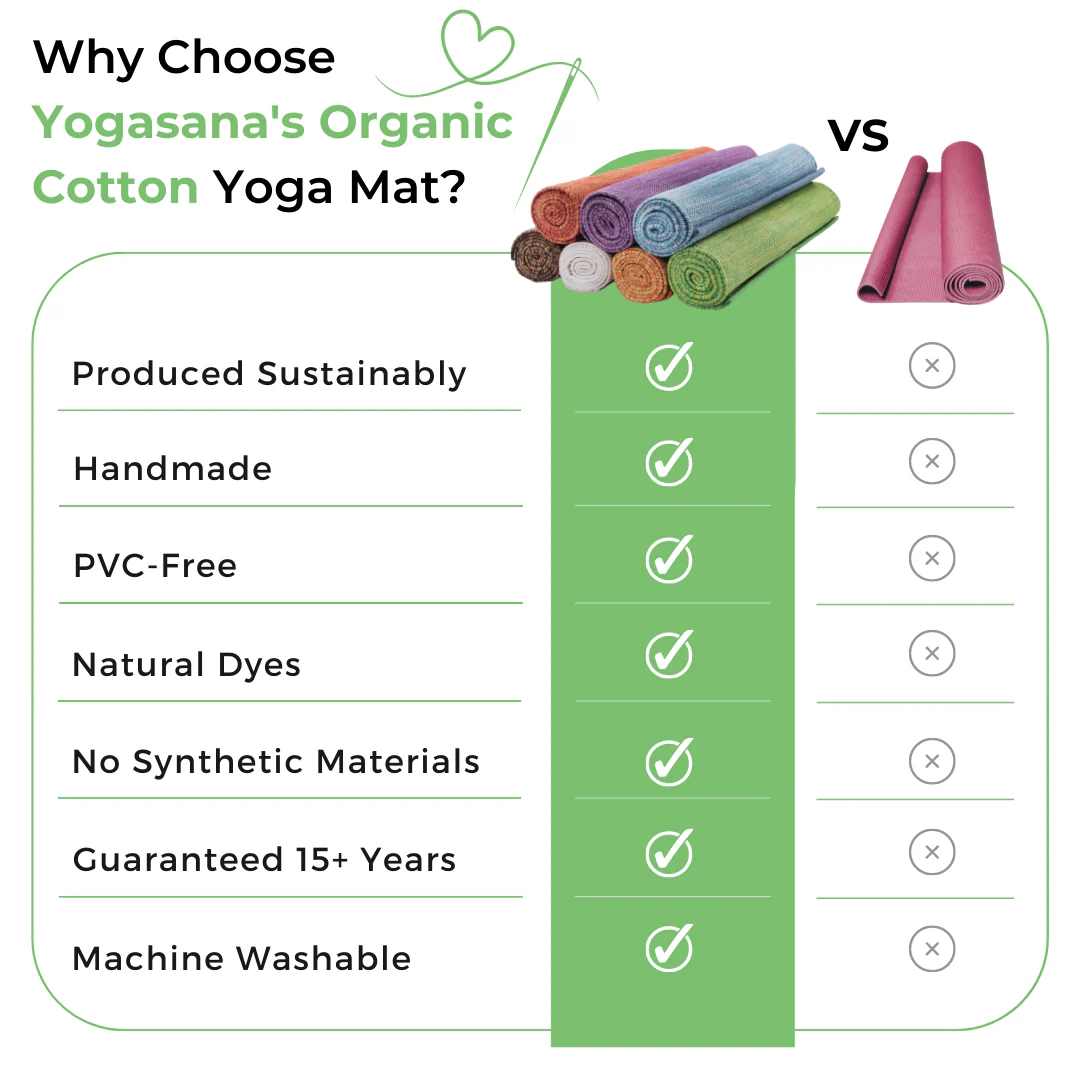Yoga mats are one of the most widely used products used by about 300 million yogis around the globe. For many years, most of the yoga mats made available on the commercial market were made with PVC — these are the conventional, plastic sticky mats you see in stores or at your local yoga studio.
However, many yogis have started to question whether yoga mats are toxic and want to know their options when looking at yoga mats.
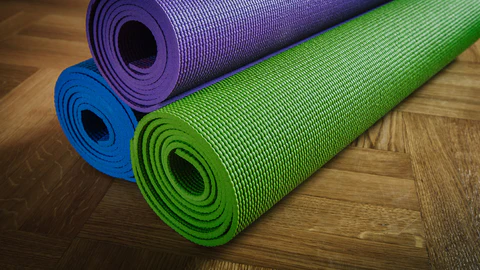
As more people enjoy the benefits of practicing yoga, a lot of companies are seeing a potential in marketing yoga mats and other accessories. Quickly, the market has been saturated by the parade of colors, textures, and materials used with prices as cheap as $10 and going up to $360 and beyond.
PVC yoga mats are the most widely used variant making a large portion of global production in that year. It is so common that many yogis don’t know they have other options — they only know about the plastic, sticky yoga mats that can be found at their nearest retail store. It’s not a surprising number given its great specs and cheap price. Mass overseas production and cheap materials make the sticky mats affordable. However, it comes at a cost.
What most people do not know is that PVC-made products actually pose a great danger on a massive scale. The risks are far reaching and environmental organizations and those in the medical field are warning the public about them.
…what do we need to know about what is in our yoga mats….?
What is PVC?
Polyvinyl chloride (PVC), also known as vinyl, is a synthetic plastic polymer used for making products like pipes, bottles, and credit cards. When softened with plasticizers, usually phthalates, it can be used to make plumbing products, signages, phonograph records, and yoga mats. It is easily pliable when heated so it can be molded in any way, shape, or form.
Vinyl chloride is a synthetic material which is the main ingredient in PVC. It’s a very harmful chemical that affects both humans and mammals, In fact, it is listed as a Hazardous Air Pollutant by the Environmental Protection Agency (EPA).
Why Is Pvc Used for Yoga Mats?
PVC is lightweight, low cost, and low maintenance plus it gives yoga mats a great grip. With the growing population of yogis worldwide, the demand for cheaper and better yoga mats have increased.
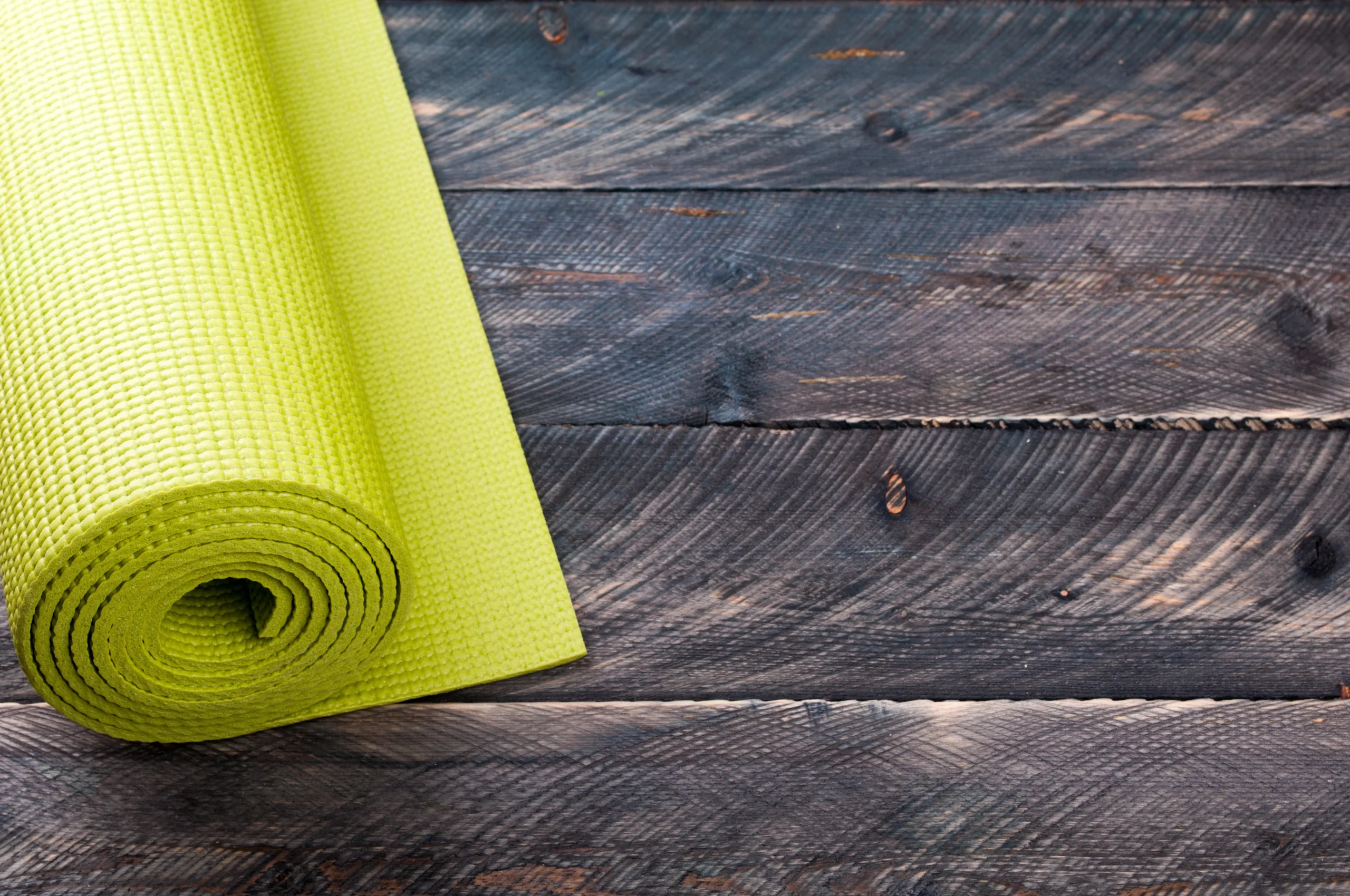
Using PVC as the main material for yoga mats allows companies to achieve this goal, raking in millions of dollars yearly (most are mass produced overseas in China).
Versatility is another reason this is a popular choice of material. Molding it to any size, shape, and thickness gives consumers a lot of variety. Blending it with other materials allows producers to play with its sponginess and stickiness, too.
Since PVC yoga mats are made of plastic, it is highly resistant to wear and tear and its smooth texture and good grip gives better performance and alignment to practitioners when changing and holding positions.
PVC yoga mats are easy to clean and it only needs soap and water before a quick rinse. This is perhaps the reason most yoga studios prefer them over more textured yoga mats that may need extra care and attention when cleaned.
However, plastic yoga mats wear down easily and need to be replaced frequently. Often, where the feet are placed in downdog position is where the mat starts to break down and pieces of the plastic mat start coming off onto your clothes and floor.
Notice where the feet connect to the mat in downdog yoga pose — this is the spot where plastic mats start to break down and flake off
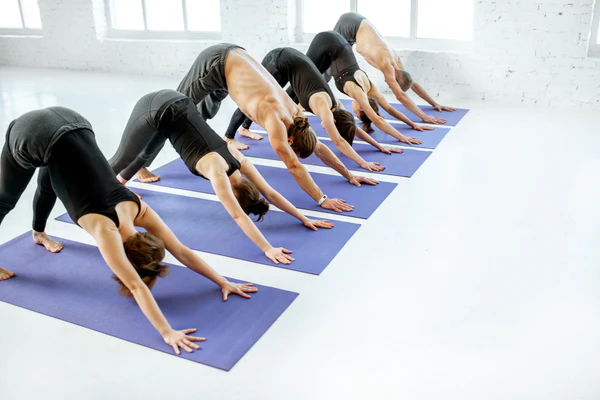
Are Yoga Mats Toxic?
It cannot be denied that PVC has been convenient for efficiency, cost and quantity. The caveat is that there is no safe way to manufacture products made from this material.
The following toxic chemicals are released in the air during manufacturing:
- Chlorine gas
- Mercury
- Vinyl Chloride
Chlorine Gas
Chlorine gas is poisonous and classified as a pulmonary irritant. It has intermediate water solubility and can cause acute respiratory tract damage. Typically, exposure to chlorine occurs due to accidental industrial or household events.
Mercury
When it is released from rock and enters the atmosphere and water, mercury gashas a negative effect on our environment.
Vinyl Chloride
Exposure to vinyl chloride increases the risk of liver cancer, brain, lung cancers, lymphoma, and leukemia.
Even after it has served you well, there’s no way possible to dispose of it without posing any risks to your health or the environment. Since there are numerous difficulties with recycling PVC, anything made with this material tends to either end up piling in landfills, clogging waterways, or thrown in the incinerator.
Either way, harmful chemicals will transfer to the air or leach chemicals into the soil. When these products are incinerated in facilities that do not have the proper equipment, the release of a toxic pollutant called dioxin will contaminate the soil and transfer to the food we eat.
The Truth About Dioxins: The Persistent Organic Pollutants (Pops)
According to the World Health Organization (WHO), there are certain effects to human health when dioxin is released depending on the length of exposure. Learn more about persistent organic pollutants (POPs) on the EPA website.
For yogis looking to achieve better physical and mental health, know that:
- Short-term exposure of humans to high levels of dioxins may result in skin lesions, such as chloracne and patchy darkening of the skin, and altered liver function.
- Long-term exposure is linked to impairment of the immune system, the developing nervous system, the endocrine system and reproductive functions.
WHO’s International Agency for Research on Cancer (IARC) also classified dioxin as a “known human carcinogen” when we get exposed in certain amounts.
Phthalates Can Be Harmful
Phthalates are softening agents used in PVC to increase their flexibility, transparency, durability, and longevity. Similar to dioxins, they are also suspected to be carcinogenic.
When exposed to phthalates for a long time, it can damage the liver, kidneys, lungs, and the reproductive system — particularly the developing testes — according to studies.
The NIH has an article explaining phthalates (including common everyday exposures):Phthalates, The Everywhere Chemical
They are endocrine disruptors, which mimic the body’s hormones.
These chemicals are released in the form of gas in our yoga mats during off-gassing, which is the process of releasing them.
These chemicals can worsen existing allergies and asthma symptoms. It can also increase the chances of getting heart disease.
Avoiding Phthalates in Pregnancy
Women who are trying to get pregnant, or who already are, should know that Phthalates in PVC has been linked to numerous health issues as well as having long lasting negative effects on the child.
Other studies found that this chemical is present everywhere around us, and so our bodies were already exposed to these chemicals anyway.
But does that mean we should neglect the choices we make with the products containing them?
The short answer is NO. Researchers and environmental advocates still rally people to make a conscious effort in avoiding products with PVC as much as we can.
In fact, since there is no law that requires companies to report their emissions of phthalates, there is no absolute way of knowing how much is in their products.
All we know is that we need to rid ourselves from getting exposed to this harmful substance more than we are now.
More research is still needed to draw the line where PVC and its toxic chemical emissions are likely to pose a threat, but our little actions in educating ourselves and avoiding the use of products made from PVC will remove us from being at risk.
What Are Healthier, More Environment-Friendly Options?
There’s plenty of better alternatives in the market that will not pose any of the health and environmental risks as PVC yoga mats would. Economical as they may seem, PVC will come to bite us back in the long run.
Do the research to help you understand the answers to the important questions when buying a yoga mat.
Questions to Ask When Choosing a Chemical-Free Yoga Mat
How Was Your Yoga Mat Made?
Was it produced in a factory where we don’t know how or where the materials were sourced? Was it handmade with love and devotion, mastery and skill?
This is important to know because the lifecycle of your yoga mat is the path that will tell you if there was something wrong along the way.
Finding a good yoga mat means looking for those that are eco-friendly from start to finish. It can be more work to research about the company and how they source their materials, but it is only a small step to take towards making better judgments even if it’s just as simple as buying your yoga mat.
Be sure it is ethically made.
For instance, knowing that child labor was in no way involved and that those who touched their products are properly compensated for their time and skills.
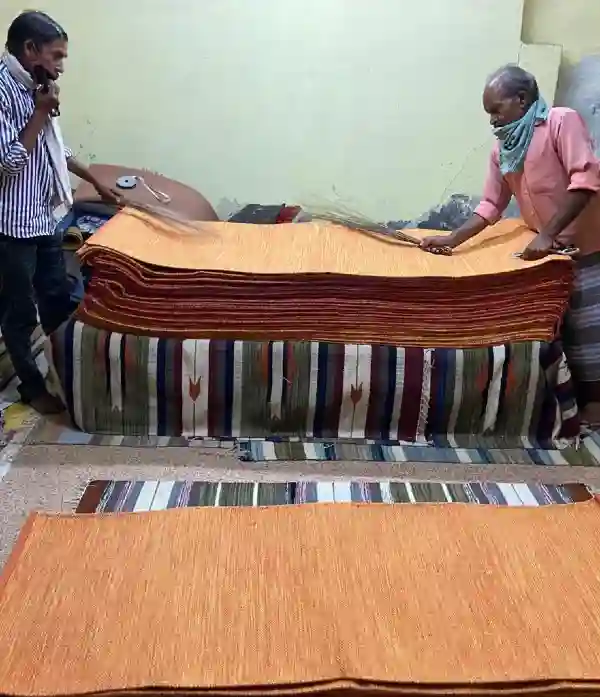
Those are some of the things that make a good eco-friendly yoga mat.
Is the Material Biodegradable?
There will come a time when you will have to say goodbye to your yoga mat because it may have been damaged beyond repair.
Perhaps if it’s a good quality yoga mat, it will have to go through many generations of use, but eventually, it will also have to bite the proverbial dust. When that happens, we must determine its ability to decompose over time and go back to nature where it was taken.
How Does It Smell or Give off Chemical Fumes?
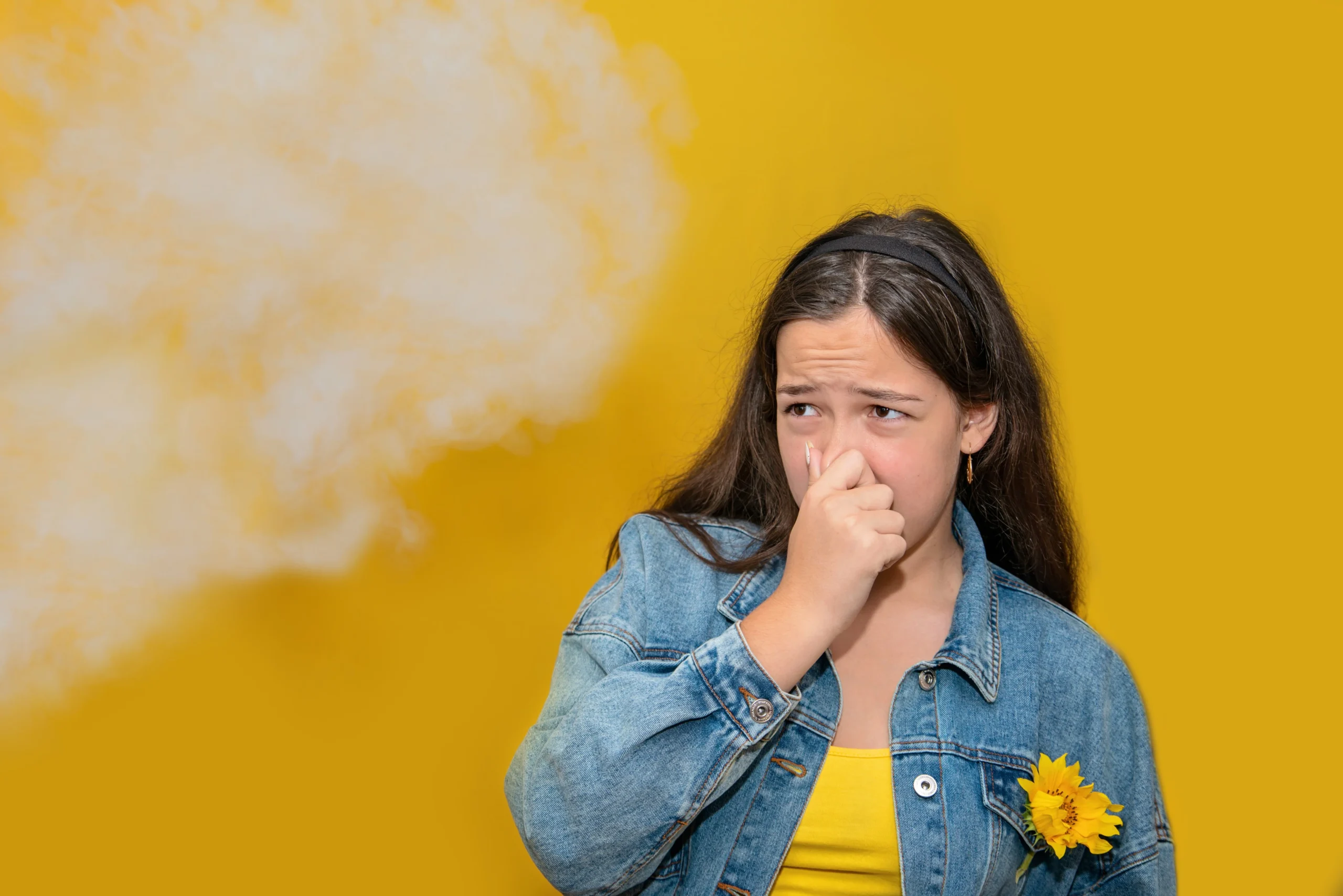
You can tell a lot just by smelling your yoga mat. That smell you get when you buy a new car, that’s the smell of chemicals you don’t want to be exposed to.
And while all natural rubber yoga mats do smell when you use them for the first time, they are not toxic and will go away over time unlike the smell you get with your PVC yoga mat.
You don’t want those fumes in your body after all.
The smell of your yoga mat may also affect your practice so choose one that does not emit any harmful chemicals nor any unwanted smell. Also, find one that is easy to clean so you don’t have to worry about sitting in a grimy, dirty yoga mat.
Does the Cost Justify the Sustainability of My Yoga Mat?
Just because the price is cheap doesn’t mean it’s economical. When purchasing an item that is way more inexpensive than others, you sacrifice the quality and therefore the lifespan of that product.
That means it will get destroyed sooner and you’ll have to buy another one more often.
The reason why most high-quality yoga mats are more expensive is because more time is used to make it. More often than not, these high-quality yoga mats are made by hand, by artisans who spent years crafting their skills to ensure you get the best.
Get a quality yoga mat that you know will not succumb to frequent body movements and exposure to heat. A high-quality yoga mat will serve you for a long time without the negative qualities of chemically treated ones.
What Are the Best Options for Yoga Mats That Doesn’t Have Chemicals?
Of course, with all things considered, it’s already a matter of preference. Most yogis who are serious about incorporating all aspects of yoga in their physical practice would tell you to go the greenest route.
Cotton yoga mats are good if you want a mat that will last for generations, easy to clean, and does not weigh so much when you bring it to the yoga studio.

They can get slippery in smooth surfaces though, but a rubber pad can be used for more traction. Rubber mats are another option as they are sticky and recyclable, though they can be allergy-inducing for those who are sensitive or allergic to latex.
There are yoga mats made of cork. Eco-friendly, antimicrobial, but can be a task to bring with you when you want to take your yoga practice out as it is heavier than most yoga mats around.
We can’t deny the fact that PVC yoga mats are quite revolutionary in terms of their cost-efficiency, durability, and versatility. It has helped millions of yogis around the world to maintain safe pose transitions during practice, but it is harder to set aside the fact that despite its many great benefits, the dangers and risks involved from their source to your hands outnumber all the good things it does.
The tenet of ahimsa dictates that we should do no harm for all living things, but looking back at the way PVC yoga mats are made from the beginning of its life until its death causes so much harm not only to the environment, but also to the people, animals, and plants that makes any form of contact with this material.
Conclusion: It Is Important to Make the Healthy Choice When Choosing Your Yoga Mat
Choosing an eco-friendly yoga mat free from harmful toxins and impurities gets you closer to nature. Embodying the principles of yoga happens beyond the mat and making a well-rounded decision to be more nature-friendly connects your body, mind, and soul together.
It helps remove your attention to the smell and focus all your energy into your practice. Each choice we make daily makes a greater impact in our lives and all those around us.
Even though it’s just as simple as buying an eco-friendly yoga mat over that cheap PVC one you saw online, it does make a huge difference. Once you have found your yoga mat, you will ready to start your yoga journey! If you need help with starting a regular yoga practice, learn about how to establish a yoga habit for beginners.
If you’re interested in learning more about organic cotton yoga mats (100% chemical free) visit our homepage: Yogasanamats.com
